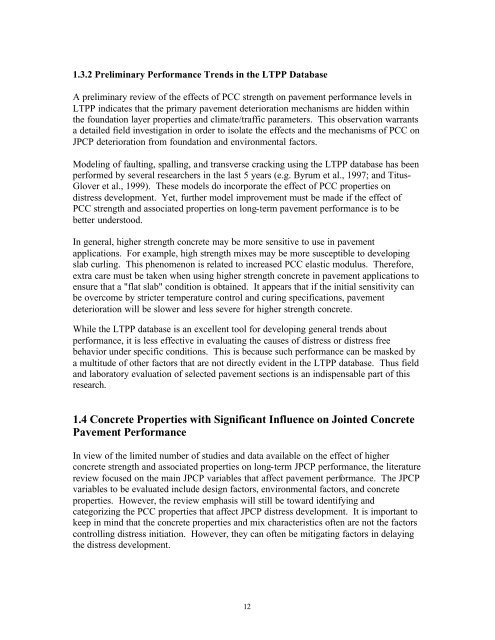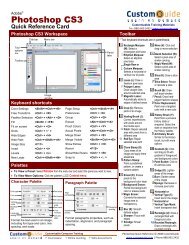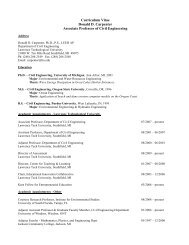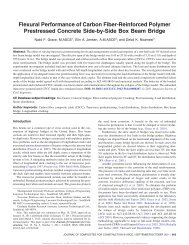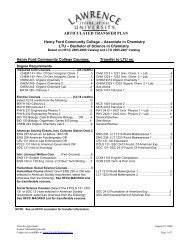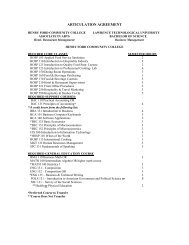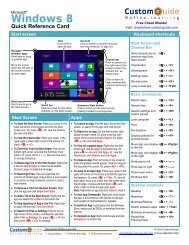The Effects of Higher Strength and Associated Concrete Properties ...
The Effects of Higher Strength and Associated Concrete Properties ...
The Effects of Higher Strength and Associated Concrete Properties ...
You also want an ePaper? Increase the reach of your titles
YUMPU automatically turns print PDFs into web optimized ePapers that Google loves.
1.3.2 Preliminary Performance Trends in the LTPP Database<br />
A preliminary review <strong>of</strong> the effects <strong>of</strong> PCC strength on pavement performance levels in<br />
LTPP indicates that the primary pavement deterioration mechanisms are hidden within<br />
the foundation layer properties <strong>and</strong> climate/traffic parameters. This observation warrants<br />
a detailed field investigation in order to isolate the effects <strong>and</strong> the mechanisms <strong>of</strong> PCC on<br />
JPCP deterioration from foundation <strong>and</strong> environmental factors.<br />
Modeling <strong>of</strong> faulting, spalling, <strong>and</strong> transverse cracking using the LTPP database has been<br />
performed by several researchers in the last 5 years (e.g. Byrum et al., 1997; <strong>and</strong> Titus-<br />
Glover et al., 1999). <strong>The</strong>se models do incorporate the effect <strong>of</strong> PCC properties on<br />
distress development. Yet, further model improvement must be made if the effect <strong>of</strong><br />
PCC strength <strong>and</strong> associated properties on long-term pavement performance is to be<br />
better understood.<br />
In general, higher strength concrete may be more sensitive to use in pavement<br />
applications. For example, high strength mixes may be more susceptible to developing<br />
slab curling. This phenomenon is related to increased PCC elastic modulus. <strong>The</strong>refore,<br />
extra care must be taken when using higher strength concrete in pavement applications to<br />
ensure that a "flat slab" condition is obtained. It appears that if the initial sensitivity can<br />
be overcome by stricter temperature control <strong>and</strong> curing specifications, pavement<br />
deterioration will be slower <strong>and</strong> less severe for higher strength concrete.<br />
While the LTPP database is an excellent tool for developing general trends about<br />
performance, it is less effective in evaluating the causes <strong>of</strong> distress or distress free<br />
behavior under specific conditions. This is because such performance can be masked by<br />
a multitude <strong>of</strong> other factors that are not directly evident in the LTPP database. Thus field<br />
<strong>and</strong> laboratory evaluation <strong>of</strong> selected pavement sections is an indispensable part <strong>of</strong> this<br />
research.<br />
1.4 <strong>Concrete</strong> <strong>Properties</strong> with Significant Influence on Jointed <strong>Concrete</strong><br />
Pavement Performance<br />
In view <strong>of</strong> the limited number <strong>of</strong> studies <strong>and</strong> data available on the effect <strong>of</strong> higher<br />
concrete strength <strong>and</strong> associated properties on long-term JPCP performance, the literature<br />
review focused on the main JPCP variables that affect pavement performance. <strong>The</strong> JPCP<br />
variables to be evaluated include design factors, environmental factors, <strong>and</strong> concrete<br />
properties. However, the review emphasis will still be toward identifying <strong>and</strong><br />
categorizing the PCC properties that affect JPCP distress development. It is important to<br />
keep in mind that the concrete properties <strong>and</strong> mix characteristics <strong>of</strong>ten are not the factors<br />
controlling distress initiation. However, they can <strong>of</strong>ten be mitigating factors in delaying<br />
the distress development.<br />
12


